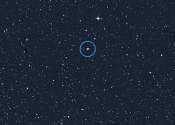Stars need a partner to spin universe's brightest explosions
When it comes to the biggest and brightest explosions seen in the Universe, University of Warwick astronomers have found that it takes two stars to make a gamma-ray burst.

When it comes to the biggest and brightest explosions seen in the Universe, University of Warwick astronomers have found that it takes two stars to make a gamma-ray burst.
Astronomy
Jan 13, 2020
0
203

Astronomers using data from NASA's Transiting Exoplanet Survey Satellite (TESS) have shown that Alpha Draconis, a well-studied star visible to the naked eye, and its fainter companion star regularly eclipse each other. While ...
Astronomy
Jan 7, 2020
0
221

In an unprecedented feat, an American research team discovered hidden secrets of an elusive exoplanet using a powerful new instrument at the 8-meter Gemini North telescope on Maunakea in Hawai'i. The findings not only classify ...
Astronomy
Aug 30, 2019
0
1059

A team of researchers from the U.S., Denmark and the U.K., working with a group at NASA's Ames Research Center, has found a binary star system that dims unpredictably. They have written a paper describing their findings and ...

Scientists from the RIKEN Cluster for Pioneering Research in Japan, Chalmers University of Technology in Sweden and the University of Virginia in the USA and collaborators have made observations of a molecular cloud that ...
Astronomy
Mar 18, 2019
278
598

Brown dwarfs are stars less massive than the sun and unable to burn hydrogen. They comprise (at least in mass) a bridge between planets and stars, and astronomers think that they form and evolve in ways different from either ...
Astronomy
Mar 4, 2019
2
282

Red giants are old stars that eject gaseous material and solid particles through a stellar wind. Some red giants appeared to lose an exceptionally large amount of mass this way. However, new observations reveal that this ...
Astronomy
Feb 25, 2019
5
185

Astronomers use stellar eclipses to study the atmosphere of accretion disks around compact stars. SRON-researchers observed this method on a low-mass X-ray binary. They find a thicker atmosphere than predicted and distinguish ...
Astronomy
Dec 12, 2018
0
261

Most stars with the mass of the sun or larger have one or more companion stars, but when and how these multiple stars form is one of the controversial central problems of astronomy. Gravity contracts the natal gas and dust ...
Astronomy
Dec 3, 2018
26
105

A stellar mass black hole is a compact object with a mass greater than three solar masses. It is so dense and has such a powerful force of attraction that not even light can escape from it. They cannot be observed directly, ...
Astronomy
Oct 22, 2018
0
524